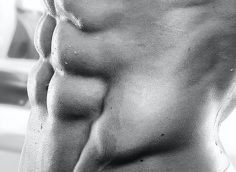I often get asked questions about how lifters should set up their yearly program.
Lifters often have some specific programs that they like, but they don't know how to put it all together, from both a health and a performance point of view. This article is my answer to those questions.
Let's assume we have a generic lifter that's been training hard consistently for a decent period of time. Let's say 3 months minimum, but 6 months or more is more common. Let's also assume this individual isn't a rank beginner, but someone who's built up a decent level of strength.
To complete the scenario, let's say he just completed a max out and he's likely feeling a little bit drained. For a competitive powerlifter this would be the time immediately following a meet, when most lifters re-evaluate their training and plan out the next cycle.
I feel it's most effective to break the training down into the 3 phases that make up the meat of this article, each phase with a specific goal and a suggested duration. You'll have to trust yourself and your body when it comes to how long to perform each stage, but I believe that regularly skipping a stage will result in compromised long-term performance.
Phase 1 – Fitness
Part of being strong and being muscular is also being fit. Being strong is great, but if you're a fat fuck that can't get up 2 flights of stairs without a break, there's something wrong.
As someone that teaches trainers who'll ultimately work with clients who want to improver their health, I can't ignore the value of health and fitness. Intense strength training performed regularly can build up undesirable compensations and weak points, at some point these issues need to be addressed.
If you move fine but are weak as piss, nobody cares about what you can do in the gym, and doing well on an overhead squat test isn't worth bragging about – nobody expects you to have any compensations when you can't squat your bodyweight for a single.
On the flip side, squatting 500 pounds is cool, but not being able to perform a good lunge without a 20-minute warm-up isn't cool. You need to have some level of balance. Otherwise it'll ultimately come back to bite you in the form of injury or reduced performance.
The goal of this training phase is to improve your overall health and fitness and to work on your weak points. By weak points, I'm not referring to the lockout portion of the bench press or something specific like that; I'm referring to the way you move compared to how you should move.
Another goal during this training phase is to allow your central nervous system to recharge from lifting heavy, which requires that you don't go heavy all the time. People can express doubt about overtraining the nervous system, but I'm convinced it does happen (ever wonder why we sleep?) and I think the stronger and more advanced you get, the more of an issue this becomes.
- Duration: This training phase will generally last 2-8 weeks in length, with 4-8 weeks being the most common.
- Training ideas: Work to achieve bodyweight mastery in the following exercises: push-ups, dips, pull-ups, sit-ups, lunges, planks, handstand push-ups (remember tools like rings and other instability elements, even the physioball, can be useful to help increase the challenge factor of these exercises).
If these exercises are hard for you, do easier versions. You can even perform machine work if you're really banged up.
Perform a lot of unilateral exercises and work to achieve good symmetry in your strength. Ben Bruno has a plethora of articles with cool unilateral versions that are useful for the person still interested in strength.
Do NOT go heavy (>75%1RM) on squats, benches, deadlifts, and presses. If you insist on continuing to use the barbell lifts, train them at 40-60% 1RM for a few reps. Five sets of 3-5 reps works well.
General Guidelines:
- Higher reps (8+, even 15-20 or more is fine).
- 1-4 sets per exercise.
- Short rest periods (under 2 minutes and preferably less than 1 minute).
- Keep workouts to less than an hour.
- Perform conditioning work 2-4 times a week on top of all this.
- Perform more total body, 'functional' exercises if possible.
- Frequency of stimulating each area/movement is likely higher (2+ times a week), the volume is medium, and the intensity (% 1RM) is low.
To sum it up, if you like the shit that I usually write about, you probably don't like this style of training. Hell, you might even make fun of it. But you shouldn't make fun of something you can't do, so just use this simple rule: if it's something you think you should be good at but you aren't, this is the time to work on it.
Phase 2 – Powerbuilding
The goal of this phase is likely what most T-Nationers think about when hitting the gym – building muscle, getting stronger, maintaining a high level of fitness and keeping body fat under control. Good lifters will often spend a considerable amount of time in this phase over the course of their lifting career.
- Duration: Usually 4-16 weeks long, with 8-12 weeks being the most common.
Guidelines:
- Training hard and consistently on the big lifts using progressive overload.
- Training the smaller synergistic and antagonistic muscles which builds muscle balance and symmetry.
- Increasing the size of the muscle and the total amount of lean .
- Maintaining/Increasing conditioning.
- Frequency is lower (1-2 x week, per muscle/movement) to promote recovery and growth.
- Volume is medium to high.
- Intensity is medium (70-85%).
- Reps are usually low to medium (3-12 reps, 5-10 is most common).
- Rest times are standard (2-5 minutes for strength, 1-2 minutes for size).
There are a lot of sample routines that are built around this idea. Some examples would be:
- The Shut Up Program I wrote for T Nation..
- The 8-Week Basic Strength Program I wrote for T Nation.
- Jim Wendler's 5/3/1 Workout Routine.
- A HIT routine very similar to what Dorian Yates' outlines in Blood and Guts.
Phase 3 – Master of Your Domain
The goal of phase 3 is to become a beast in the specific lift(s) or skills that you want to dominate. For the competitive powerlifter, this is preparing to hit a max in the big 3, plus curls if you're one of those gay curlers (which I proudly am).
For the weekend warrior, it may just be about upping their bench to shame their buddies or hitting that triple bodyweight deadlift they've always wanted to do. The idea is that we're going to peak for something, even if it means it's at the expense of something else.
Specialization is for insects, huh? Well, it's pretty hard to stand out from the crowd of 7 billion people if you don't specialize in something. Having a bunch of generalists who aren't great at anything doesn't do the collective much good. The world is becoming more specialized, not less, and if you want to shine you need to accept that.
- Duration: Usually 4-12 weeks, with 6-10 weeks being the most common.
Guidelines:
- Low reps in the exercise you'll test in.
- Long rest to boost performance.
- Heavy weight (>85% 1RM).
- Use a higher frequency on the lifts when appropriate.
- High volume if you can handle it.
- Conditioning work is minimized or decreased.
- Additional extra physical activity is discontinued (no flag football, etc.).
- Focus your energy on no more than 5 key lifts, the fewer the better.
- Isolation exercises and unrelated assistance work should be minimized or dropped to promote recovery/save energy.
Sample workout programs designed for this stage include:
- The 8 Weeks to a Super Bench article I wrote for T Nation.
- The 10 Weeks to Squat PRs I wrote for T Nation.
- The 2 above programs can be combined to peak for a full meet.
- A Westside Routine.
Conclusion
I believe that a plan like this can yield very significant long-term results. I used this type of program to take my total, which had been stuck at 1400 for 2 years, to over 1600 in another 2 years.
Below, in graph form, is a visual representation of what your progress might look like.
Spend approximately one month staying healthy and fit and don't lift heavy. Spend 3 months rocking out good solid workouts, building up all-around strength and adding muscle mass to your body. Spend 2 months peaking for an event. Repeat that entire cycle again to flesh out 12 months.
Repeat that cycle again a few times, and over time your 10RM becomes higher than your former 1RM, which you had to work hard to achieve.
I realize that in the graph it shows that, 2 months after your peak, your strength is lower than where it used to be. Don't worry, 4-6 months after that last peak, your new peak will be significantly higher in all areas and hopefully you'll be less prone to injury and have improved health.
Those things go a long way to building longevity in the sport. Follow this yearly plan and you'll achieve what we all want: to Lift Long and Prosper.







